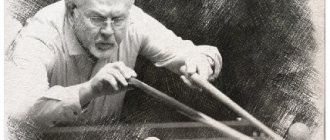Biography
Emperor of All Russia Pavel the First is the successor of the royal family of the Romanovs. He is the son of Catherine II and Peter III, although because of his father’s jokes on the topic “it’s unknown where his wife got her children,” many consider the father of Paul I to be Catherine Alekseevna’s favorite, Sergei Saltykov. Moreover, the first-born was born only after 10 years of marriage. However, the external similarity between Paul and Peter should be considered as a response to such rumors. The childhood of the future autocrat cannot be called happy. Because of the political struggle, the current Empress Elizabeth I Petrovna was afraid for Paul the First, protected him from communication with his parents and surrounded him with a real army of nannies and teachers who curry favor with high-ranking officials rather than worry about the boy.
Pavel the First in childhood | Runiverse
The biography of Paul I claims that he received the best education that was possible at that time. The extensive library of Academician Korf was placed at his personal disposal. Teachers taught the heir to the throne not only the traditional Law of God, foreign languages, dancing and fencing, but also painting, as well as history, geography, arithmetic and even astronomy. It is interesting that none of the lessons included anything related to military affairs, but the inquisitive teenager himself became interested in this science and mastered it at a fairly high level.
Pavel the First in his youth | Arguments and Facts
When Catherine II ascended the throne, she allegedly signed an obligation to transfer the reign to her son Paul I when he reached adulthood. This document has not reached us: perhaps the empress destroyed the paper, or maybe it is just a legend. But it was precisely such a statement that all the rebels dissatisfied with the rule of the “Iron German,” including Emelyan Pugachev, always referred to. In addition, there was talk that already on her deathbed, Elizaveta Petrovna was going to transfer the crown to her grandson Paul I, and not to her nephew Peter III, but the corresponding order was not made public and this decision did not affect the biography of Paul I.
Separation from parents
By the time Pavel was born, Elizaveta Petrovna was disappointed in his dad. She did not notice in him those qualities that could help him be a worthy ruler. With the birth of Paul, the Empress decided to independently educate him, making him her own successor. In this regard, when the boy was born, he was surrounded by a staff of nannies, and the parents were removed from the child.
Peter III was quite happy with the opportunity to see his son once a week, because he was not sure that genetically this was his son. Catherine initially had tender feelings for the child, but over time she became more and more distant from him. From birth, she rarely saw her son and only with the permission of the empress. Moreover, she gave birth to him from an unloved husband.
Upbringing
The cold attitude of his mother, many educators with different views and intrigues at court did their job: Pavel grew up as a suspicious and distrustful person who feared an attempt on his own life.
Read also: Interesting facts about the life of E. Baratynsky, biography, creative path
They dealt with the future emperor seriously. Elizaveta Petrovna even came up with special instructions, where she prescribed the key points of his upbringing and training. She also appointed Nikita Ivanovich Panin as a teacher for the boy.
Pavel the First was considered a capable student, although he was restless. The education he acquired was the best at that time.
The lifestyle of the future heir was similar to that of a barracks: getting up at 6 am and studying with breaks for dinner and lunch.
In the evenings, Pavel enjoyed non-childish entertainment: balls and receptions.
Accession to the throne
In 1797, Emperor Paul I was crowned. The first thing he did upon ascending the throne was to order the ashes of Peter III to be removed from the grave, crowned and reburied in a neighboring grave on the same day as Catherine II.
If we talk about what nickname Emperor Paul I forbade the use of, then this is the word “snub-nosed”, because he himself was like that.
Emperor
Paul the First sat on the throne of the Russian Empire only at the age of 42. Right during the coronation, he announced changes in the succession to the throne: now only men could rule Russia, and the crown was passed on only from father to son. By this, Paul unsuccessfully hoped to prevent the palace coups that had become more frequent recently. By the way, for the first time in history, the coronation procedure took place simultaneously for both the emperor and the empress on the same day.
The disgusting relationship with his mother led to the fact that Paul I chose the method of leading the country to actually contrast his decisions with its previous ones. As if “to spite” the memory of Ekaterina Alekseevna, Pavel the First returned freedom to convicted radicals, reformed the army and began to fight serfdom.
Pavel the First | Petersburg stories
But in reality, all these ideas did not lead to anything good. The liberation of the radicals would come back many years later in the form of a Decembrist uprising, the reduction of the corvee remained only on paper, and the fight against corruption in the army grew into a series of repressions. Moreover, both the highest ranks, who one after another were deprived of their positions, and ordinary military personnel remained dissatisfied with the emperor. They grumbled about the new uniform, modeled on the Prussian army, which turned out to be incredibly uncomfortable. In foreign policy, Paul the First became famous for his fight against the ideas of the French Revolution. He introduced the strictest censorship in book publishing; French books and French fashion, including round hats, were banned.
Pavel the First | Wikipedia
During the reign of Paul the First, thanks to commander Alexander Suvorov and Vice Admiral Fyodor Ushakov, the Russian army and navy achieved many significant victories, collaborating with Prussian and Austrian troops. But later Paul I showed his fickle character, broke off relations with his allies and formed an alliance with Napoleon. It was in Bonaparte that the Russian emperor saw the force that could stop the anti-monarchist revolution. But he was mistaken strategically: Napoleon did not become a winner even after the death of Paul the First, but because of his decision and the economic blockade of Great Britain, Russia lost its largest sales market, which had a very significant impact on the standard of living in the Russian Empire.
↑ Domestic policy of Paul I
On April 5, 1797, Paul I was anointed king. On the same day, a decree on succession to the throne was issued. Now the direct descendants of the monarch through the male line became the heirs to the Russian throne. Women could take the Russian throne only in the absence of male representatives from the ruling dynasty
Paul I restored the State Council, created under Catherine II, but not functioning for a long time. Increased the number of council members from 7 to 17 people. In 1796, the Senate was also reformed, which could not cope with its duties due to the increased number of cases.
The size of the Senate has increased, and new rules of office work have appeared aimed at speeding up the work of the Senate. The internal policy of Paul I caused discontent among the nobles, because... The emperor tried to alleviate the situation of the peasantry. Such actions caused certain discontent among the nobility.
He also, by his decrees, abolished Catherine’s “charter of the nobility.” Now nobles were forbidden to ask for resignation if they had served as an officer for less than a year. The noble assemblies were abolished. The army reform carried out by Paul I caused great dissatisfaction. Prussian orders were established in the Russian army, and an inconvenient uniform was introduced. The army lived by drill training, under conditions of the strictest discipline.
Personal life
Officially, Pavel the First was married twice. His first wife, Grand Duchess Natalya Alekseevna, was by birth the German Princess Wilhelmina of Hesse-Darmstadt. She died two years after the wedding during childbirth. The first son of Paul I was born dead. That same year, the future emperor married again. The wife of Paul the First, Maria Feodorovna, was called Sophia Maria Dorothea of Württemberg before marriage, and she was destined to become the mother of two rulers at once, Alexander I and Nicholas I.
Princess Natalya Alekseevna, first wife of Paul I | Pinterest
It is interesting that this marriage was not just beneficial for the state, Pavel really fell in love with this girl. As he wrote to his family, “this blonde with a pleasant face captivated the widower.” In total, in union with Maria Feodorovna, the emperor had 10 children. In addition to the two above-mentioned autocrats, it is worth noting Mikhail Pavlovich, who founded the first Russian Artillery School in St. Petersburg. By the way, he is the only child born during the reign of Paul the First.
Paul I and Maria Feodorovna surrounded by children | Wikipedia
But falling in love with his wife did not stop Paul the First from following the generally accepted rules and having favorites. Two of them, ladies-in-waiting Sofya Ushakova and Mavra Yuryeva, even gave birth to illegitimate children from the emperor. It is also worth noting Ekaterina Nelidova, who had enormous influence on the emperor and it is believed that she tried to lead the country with the hands of her lover. The personal life of Paul I and Ekaterina Nelidova was more intellectual than carnal in nature. In it, the emperor realized his ideas of romantic chivalry.
Favorites of Paul I, Ekaterina Nelidova and Anna Lopukhina
When those close to the court realized how much the power of this woman had increased, they arranged a “replacement” for the favorite of Paul I. Anna Lopukhina became his new lady of the heart, and Nelidova was forced to retire to Lode Castle, in the territory of present-day Estonia. It is curious that Lopukhina was not happy with this state of affairs, she was burdened by the status of the mistress of the ruler Paul the First, his “knightly” manifestations of attention, and was annoyed that these relationships were being put on display.
Foreign policy
Upon accession to the throne, P. I declared peace and non-interference in Europe. affairs, interrupted preparations for war against the revolutionaries. France and canceled recruitment, and also stopped the Persian Campaign of 1796, during which it grew. troops occupied the coast of the Caspian Sea and threatened Tehran. With the strengthening of France’s position in Europe (1798), P. I, in order to restore the “shocked thrones,” took part in the creation of the 2nd anti-French coalition.
Performing ally. obligations, sent growing. F. F. Ushakov's squadron to the Mediterranean for joint actions with the Anglo-tour. fleet (Mediterranean campaign 1798–1800), expedition. corps under general command. A. V. Suvorov to Italy (Italian campaign 1799) and Switzerland (Swiss campaign 1799) for joint actions with the Austrian. troops, as well as a corps to Holland to restore the power of the Dutch. Stadtholder (Russian-English expedition 1799). Ushakov's squadron cleared the French. troops of the South Italy, the Ionian Islands and about. Corfu, Russian-Austrian troops occupied the North. Italy; however, after heroic. After Suvorov's troops crossed the Alps to Switzerland, they were forced to retreat to Bavaria, left without the support of the Austrians. troops, in which P. I saw the betrayal of Austria's allies. obligations. The expedition to the Netherlands ended in failure. Dissatisfied with the behavior of the Allies and having received Great Britain's refusal to return Fr. Malta (occupied by British troops in 1800), P. I withdrew from the anti-French coalition and sharply changed foreign policy. well. He began to pursue a policy of rapprochement with France, where, as a result of the state. The coup in 1799 established the essentially monarchical power of the first consul, Napoleon Bonaparte. On the initiative of P. I, a convention on weapons was concluded between Russia, Prussia, Sweden and Denmark 4(16)–6(18).12.1800. neutrality, actually directed against Great Britain. Introduced an embargo on the import of English. goods. He discussed with Napoleon Bonaparte a plan for a joint campaign against India, the beginning of which was the campaign of the Don Cossacks under command. Ataman M.I. Platov (interrupted after the death of P. I). In the beginning. 1801 forced the French. the exiled king Louis XVIII left Mitau Castle (where it provided him with shelter in 1798) and left Russia.
Death
During the several years of Paul the First's reign, despite the change in succession, at least three conspiracies were organized against him, the last of which was successful. Almost a dozen officers, commanders of the most famous regiments, as well as government officials on the night of March 24, 1801 entered the emperor’s bedroom in the Mikhailovsky Castle and committed the murder of Paul I. The official cause of his death was apoplexy. It is worth noting that nobles and ordinary people greeted the news of death with poorly controlled glee.
Engraving “The Assassination of Emperor Paul I”, 1880 | Wikipedia
The perception of Paul the First by subsequent generations is ambiguous. Some historians, especially during the reign of his successor Alexander I, and then in Soviet times, created the image of a tyrant and tyrant. Even the poet Alexander Pushkin, in his ode “Liberty,” called him “a crowned villain.” Others try to emphasize Paul the First’s heightened sense of justice, calling him “the only romantic on the throne” and “the Russian Hamlet.” The Orthodox Church even at one time considered the possibility of canonizing this man. Today it is generally accepted that Paul the First does not fit into the system of any known ideology.
Alternative view
Biography of Paul I
Russian Emperor Pavel I Petrovich - born: October 1, 1754 died: March 24, 1801. From the Romanov dynasty, son of Catherine II and Peter III.
—
Childhood of Paul I
Pavel was born under rather mysterious circumstances. Emperor Peter III and Catherine II did not have an heir for 10 years. This was explained quite simply: Peter was a chronic alcoholic. And yet the empress managed to get pregnant. Many did not consider Peter III to be the father of the baby, but they preferred to keep quiet about it.
The birth of the long-awaited child did not bring happiness to the parents. The emperor suspected that the child was not his, and the mother treated the boy’s appearance more like a “state project.” Pavel experienced all the horror of the saying: “Seven nannies have a child without an eye.” They often forgot to feed him, dropped him several times, and he was left alone for a long time. He hasn't seen his parents for years! The boy grew up fearful, withdrawn and deeply unhappy...
Paul I - Aside from the throne
Promotional video:
1762 - Peter III was overthrown, and for 34 long years the Russian throne was occupied by his wife Catherine II. Catherine treated her son rather coldly: he was, first of all, the direct heir to the throne, and she did not intend to share power with anyone.
1772, September 20 - Paul turned 18 years old - it’s time to take the throne. But from his mother he received only the rank of admiral general of the Russian fleet and colonel of a cuirassier regiment. For the young prince, this was the first serious humiliation, followed by others: he was not awarded a place in either the Senate or the Imperial Council. On April 21, on her birthday, Catherine gave the prince a cheap watch, and her favorite Count Potemkin an expensive one for 50,000 rubles. And this in front of the entire yard!
Paul I - between two worlds
In order for the prince to think less about power, the empress decided to marry him. The choice was made on the Prussian Princess Wilhelmina. 1773, autumn - the young people got married. Expectations were not met; the marriage did not bring happiness to Pavel. His wife, as it turned out, was a powerful woman - she actually subjugated her husband and began to cheat on him. This did not last long - 3 years later, Wilhelmina died in childbirth. Catherine consoled the grief-stricken prince in a unique way: by personally conveying to Pavel the love correspondence between the princess and Razumovsky, a close friend of the prince. After the double betrayal, Pavel became an even more gloomy and closed person.
Pavel did not remain single for long and in the same 1776 he went to Berlin to meet the 17-year-old Princess Sophia Dorothea. Prussia made a strong impression on Paul: unlike Russia, order and exemplary morality reigned among the Germans. Pavel's respect for a foreign country quickly grew into sympathy for his bride; the princess reciprocated. 1776, October - the wedding took place. In Russia, Sofia-Dorothea received the name Maria Fedorovna.
For many years, Pavel lived in two worlds - in his personal life he enjoyed happiness, and in his public life he suffered from universal contempt. If Europe had long revered him as a full-fledged emperor, then in Russia the courtiers looked at him with a grin - the country was ruled by Catherine II with her lover Count Potemkin.
When Paul's sons began to grow up, Catherine personally began to raise them, demonstrating that she would rather allow one of her grandchildren to ascend to the throne than her own son. Paul's patience was still not limitless... 1783, May 12 - a final quarrel occurred between the Empress and Paul. That same year, in August, his mother gave Pavel an estate near St. Petersburg. This meant only one thing - voluntary exile.
Paul I - exile
The donated estate became for Paul both a place of unspoken exile and an island of long-awaited freedom.
The first thing Pavel did was defend the right to have three personal battalions consisting of 2,399 people in Gatchina. They lived and served according to Prussian laws; The prince himself conducted daily exercises.
After beating up the soldiers, Pavel set off to supervise numerous construction projects. In Gatchina, under his leadership, a hospital, a school, factories specializing in the production of porcelain and glass, 4 churches (Orthodox, Lutheran, Catholic and Finnish), as well as a library were built. Its collections included 36,000 volumes.
The prince forgot his harshness and unsociability only in the evenings with his loved ones. He spent all his evenings with his wife Maria Feodorovna. The dinner was modest - a glass of Burgundy claret and sausages and cabbage. It seemed that all his life he would be content with this measured and calm life.
Paul I - reforms
The death of Catherine II was sudden - on November 6, 1796 from apoplexy. If Catherine had lived for more than six months, Alexander would have ascended the throne. All the papers with the order for his succession were prepared.
The unexpected power became for Paul 1 not only a long-awaited gift, but also a real curse: the country was in a terrible state. The ruble depreciated, corruption and theft flourished everywhere, and about 12,000 unsolved cases accumulated in the Senate. Three quarters of the Russian army's officer corps existed only on paper. Many received ranks without even serving, desertion became the norm, and the fleet was still equipped with cannons from the times of Peter the Great.
The emperor began to fight harshly against lawlessness and the decline of morals. Arrests, trials and exiles swept across the country. Neither connections nor past merits could save them from punishment from higher ranks. It was not easy for the officers either: carousing and trips to balls were prohibited by Pavel, and they were replaced by early rises and exhausting exercises. Ordinary officials also expressed dissatisfaction with Paul's reforms - they should have been at work at five in the morning.
Paul 1 was in power for only 4 years and 4 months. During this time, he demoted 7 marshals and more than 300 senior officers, distributed 600,000 peasants to landowners and issued 2,179 laws.
Despite the emperor's harsh temperament, his eldest son Alexander was always on his father's side. However, Paul 1 managed to lose this ally too. Once he called the prince a fool in front of everyone, which turned the heir against himself.
Bloody night
Paul 1 had a presentiment of his death. At least this is evidenced by many of the memoirs of his contemporaries.
S.M. Golitsyn wrote about the last evening: “It was customary that at the end of dinner everyone went into another room and said goodbye to the emperor. That evening he did not say goodbye to anyone and said only: “What happens, cannot be avoided.”
Another eyewitness wrote: “After dinner, the emperor looked at himself in the mirror, which had a flaw and made his faces crooked. He laughed at this saying: “Look how funny the mirror is; I see myself in it, with my neck to the side.” This was an hour and a half before his death...”
...The last meeting of the conspirators took place on the night of March 12, 1801. Everything was led by General Bennigsen, the Zubov princes, and also Count Palen. Dissatisfaction with the policies of Paul 1 took place over champagne and wine. Having invigorated themselves with drinks, the conspirators went to the chambers of Paul 1.
After passing two sentries, the men burst into the emperor. Zubov made an offer to Pavel 1 to sign an act of renunciation. The emperor's refusal infuriated the uninvited visitors. According to one version, the emperor was strangled with a pillow, and then his body was hacked to pieces with sabers.
Even before dawn, news spread across the Northern capital that the emperor had suddenly died from an “apoplexy,” and Alexander ascended the throne. Stormy fun began in St. Petersburg...
A few years later, General Y.I. Sanglen, head of the secret police under Alexander 1, wrote: “Paul will forever remain a psychological problem. With a kind, sensitive heart, an exalted soul, an enlightened mind, a fiery love for justice... he was an object of horror for his subjects.” The nature of Paul 1 was never fully understood either by his contemporaries or descendants-historians.
"Interesting newspaper"











